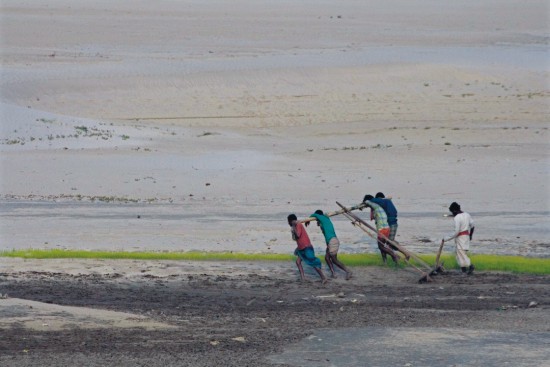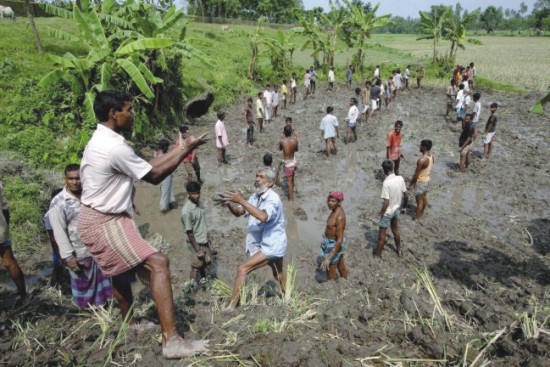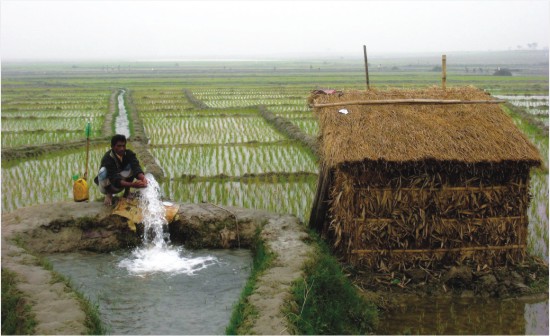
Inside
|
Dui Bigha Jomi Shahana Siddiqui and Sheikh Naveed Ahmed discuss land use and resettlement in Bangladesh
Why do we never speak of land? We speak of variables that affect land, such as climate change. We speak of the implications of land related issues on people's livelihoods, such as erosion of land. But land for its own worth has in many ways lost its appeal to academics and policymakers. Yet, land remains the central and salient issue for development imperative in Bangladesh. It took policymakers over 30 years to draft a land use policy, to sketch a rough diagram of what is the future of land application in Bangladesh. We have taken for granted that Bangladesh will always be an agro-based economy. But with changes in time, structure of the economy is shifting with the pressing needs to industrialise. But then, where is the land for these shifts and how to use it efficiently? In a country that harbours 140 million people within the geographical limitations of 55,000 square miles, land is increasingly a valuable and scare resource. Along with human induced land mismanagement, natural environmental and climate variability are impacting the land patterns of Bangladesh. Food security has evolved as a major crisis in the last few years and in many ways has its roots in the land mismanagement of the country. To become a middle-income nation, industrialisation and modernisation of labour force and production processes are on the priority list. High population density, land scarcity, need for agriculture for food security, need for industrialisation for growth -- how do we fit all these issues within such small geographical peripheries? The Bangladesh National Land Use Policy, 2002 recognises the land use constraints and the promotion of agricultural use of the land (crop production, fishery, forestry and livestock). It also highlights the decline of productivity due to unplanned and improper uses of land. In Acquiring mismanaged land Over 80% of all civil disputes are over land. Even criminal offences, such as murders and other hostilities surround land disputes. Since land is scarce and claimants are many, corruption is high in this sector. People find creative ways, both in and out of the administration to gain control over land in both rural and urban areas.
Land management is, therefore, usually viewed as a resource management challenge in relation to the relevant land laws and practices. In effect, land mismanagement is also mainly due to the lack of knowledge and skills required by government officers and other professionals responsible for different activities and decision-making regarding land use. Especially in the modern times when Bangladesh is moving towards industrialisation through the private sector, the serious lack of professional cadres in both government and private sectors able to address the complex issues of land management is being increasingly felt. Bangladesh has displayed strong economic indicators as a growing economy (despite all its political drawbacks), with a greater focus on the industrialisation process for economic sustainability and growth. Internationally Bangladesh is considered as an economically viable investment destination, attracting FDIs and remittances. Foreign investments are entering in collaboration with the government as well as the private sector. Investments range from heavy industries, such as the proposed TATA car plant to the booming service industry especially in the telecommunications sector. For these investments to be a reality, development footprints, big or small, need to be strategically positioned in different areas of Bangladesh. The question is where? We have yet to mark industrial zoning areas, commercial agricultural areas, and other economic zones. Zoning is a difficult exercise because every inch of land in Bangladesh is occupied, lived on, cultivated, extracted, utilised in one form or the other, legally, extra-legally, and/or illegally. In the absence of a clear land use policy for industrial purpose as well as outdated land acquisition laws such as the Land Acquisition Law, 1894 and the Acquisition and Requisition of Immovable Property Ordinance 1982, land acquisition for both private and public sector developments face serious challenges especially with their resettlement plans. The push for industrialisation means that along with industries supporting infrastructure development in the form of roads and highways, power plants, water management and gas supply must also be undertaken simultaneously. For both the primary and secondary infrastructures to be built, a substantial amount of land would be required by the implementing agencies. The acquisition of land for project footprints immediately implies that a large number of people would have to be physically and economically displaced either on a temporary or permanent basis. The question is how to address these issues of economic displacement within the context of sustainable development? Shegun to Begun: valuation, compensation and livelihoods The Jamuna Bridge project marked the first ever large-scale, planned resettlement that took into account of certain level of people's participation and grievances. This was to be the first departure from the “business as usual” process of financial compensation taking into account no consideration the permanent changes in the socio-economic dynamics of the affected people. Even with the Jamuna Bridge resettlement plans, different implementing agencies applied different steps in acquiring land and resettling the affected people. The focus still remained on financial compensation and a one-off package that did not value the importance of the people's various relations with land. There were also widespread allegations that not the real affected people but squatters brought from elsewhere by middlemen received the bulk of the financial compensations. The entire experience of being displaced leaves behind a deep mark in the people's way of life. Communities are disrupted, social structures are fragmented, and specific groups such as women, lose out on their social networks, which are vital to their subsistence, and in many cases their overall existence. Awareness raising and strengthening technical capacity of project managers are taking place on an ad hoc basis or through “learning-by-doing” depending on the different development partners and their international requirements and standards. There is a slow but a much needed paradigm shift in the consultation and participatory approach to resettlement projects. People are given a face, an identity and a context which is then evaluated for compensation valuation and livelihood restoration. The root problems of years of mismanaged and unorganised land sale, revenue, survey and mutation records create serious difficulties for implementing agencies to differentiate owners from political thugs and middlemen. Cultural impediments such as generational hand over of property rights without formal mutation records are equally frustrating and problematic to projects. Land surveys take a long time to be completed and therefore become outdated when referred to for boundary disputes. On the other hand, people also harbour deep fear and suspicion about the state machinery and its complex laws, procedures and practices regarding land. This discourages the people from approaching the land-related government representatives at the local level. Land and asset valuations are usually convoluted by the coercion of both evaluators and the people. There are stories of how begun (eggplant) plants are recorded as shegun (Teak) trees for higher compensation packages. Such discrepancies at every level usually lead to delays in the project, which imposes a higher cost of implementation on all stakeholders. Resettlement and livelihood restoration should be viewed as an opportunity for sustainable development for the affected people. But the larger question still remains as to how do we envision this sustainable development? When providing a compensation package, do we want the affected farmers to continue in their traditional trade, or is that the opportune moment to provide training, so that they can diversify their skills? But in doing so, are we creating the necessary secondary support systems and markets to absorb the newly developed skills? The land question is, therefore, intrinsically connected to not only people's access to physical resources, but to the overall question of human capital enhancement.
Where do we go from here? The Ministry of Land and other relevant government agencies and their officers handling the various issues of land, from acquisition to conflict resolution, surveying and resettlement planning, must be adequately trained in international practices, local realities and most of all in ensuring people's participation. Conformity of policies and laws is necessary but it is also equally important to innovate creative solutions by thinking out of the box with the existing framework. As large footprints are important to the growth of the economy, just resettlement and rehabilitation programs are essential for sustainable development. Shahana Siddiqui and Sheikh Naveed Ahmed work at BRAC Development Institute, BRAC University. |

 addition, water bodies are being filled for housing and shopping and aquatic bio-diversity is being depleted with the misappropriation of wetland. Like so many policies in Bangladesh, the Land Use Policy does not discuss the constraints and concerns embedded within the existing legal structure on land. The Policy neither discusses the long-term vision with the existing land mass and how to integrate the growing need for industrialisation and to sustain the traditional agro-based economy. One wonders what philosophy and ideals underpin the thought process of policymakers who drafted these hollow policies that in essence shape the country's future.
addition, water bodies are being filled for housing and shopping and aquatic bio-diversity is being depleted with the misappropriation of wetland. Like so many policies in Bangladesh, the Land Use Policy does not discuss the constraints and concerns embedded within the existing legal structure on land. The Policy neither discusses the long-term vision with the existing land mass and how to integrate the growing need for industrialisation and to sustain the traditional agro-based economy. One wonders what philosophy and ideals underpin the thought process of policymakers who drafted these hollow policies that in essence shape the country's future.

